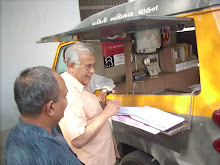Free Press Journal: Tamil Nadu: Tuesday, September 26,
2017.
In most
cricket playing nations in the world, it is next to impossible to find viable
television audience for domestic cricket. But it’s a different case with Indian
Premier League (IPL), a domestic league consumed primarily for its
entertainment quotient. Earlier this month, the media rights television and
digital of IPL were sold for humongous Rs. 16,347.5 crore ( $2.55 billion) for
a period of five years. This is an increase of 158 per cent in value from the
previous cycle. What’s more, with Star India paying a fortune to BCCI, the
cricket board has also ended up making more money than it has in its entire
history.
Interestingly,
for five-year media rights Star has paid more than twice the amount Sony
Pictures Network (SPN) had paid for 10 years. That’s largely because one
property that Star badly missed in its sports portfolio was IPL. Star has a
bouquet of 12 sports channels. It sources content from different properties
across the world. Currently, it has the rights for Indian cricket, besides
owning cricket rights for ICC, ECB (England), Cricket Australia and Asian
Cricket Council. Star’s highly aggressive bid for IPL is in line with the
network’s aggressive investment in sports properties over the past five years.
This will give Star a complete monopoly over cricket in India.
What has
stumped media analysts is that IPL is now more valuable than international
cricket involving India. For instance, while Star pays Rs. 43 crore to BCCI for
every international match played in India, BCCI will earn Rs. 54.49 crore per
IPL match or Rs. 3,269.50 per season, against Rs. 820 crore before. That makes
IPL a jewel in BCCI’s crown. But it is also a fact that not only IPL has been
the most controversial league since its inception, it has also landed BCCI in
all sorts of controversies and problems, including its current face-off with
the Supreme Court over reforms. Two questions arise. One, has Star paid too
much for a domestic league of 300 T-20 matches per season? Two, why star put a
Rs. 8,465 crore premium on the consolidated rights over sum of individual
property rights?
The price
certainly looks stretched, notwithstanding the fact that IPL is the single
largest and most impactful media property which has delivered high reach and
viewership across demographics. Star’s recklessness can be explained by the
fact that it expected aggressive bids from its rivals, both TV and digital
networks. The fact that the most aggressive digital bid came from Facebook
proves that apart from TV, cricket in India, particularly IPL, is a must-have
property for growth of digital business as well. There are three revenue
streams – television advertising, subscription (cable and DTH operators) and
digital (advertising and digital). Television is the biggest revenue generator,
followed by subscription, while digital is a growing business.
The first
edition of IPL fetched Rs. 350 crore in advertising revenue for Sony; the last
edition in 2017 clocked Rs. 1300 crore. Advertising revenue sees 10 to 15 per
cent year-on-year growth. For IPL-10, the average 10-second ad rate was Rs. 6
lakh. Revenue from subscription accounts for about 40 per cent of advertising
revenue. This gives a fair indication of how much money Sony must have made
from TV rights on its investment of Rs. 8,200 crore. But the challenge for Star
is too huge: Rs. 18,000 to 20,000 crore in five years, or about Rs. 3,500 to
4,000 crore a year. This will require increasing ad rates by over 200 to 250
per cent, besides pressuring cable TV and DTH operators to shell out more. It
is one thing to say that premium assets are given more premiums for high impact
properties like the IPL. But IPL is not an India-Pakistan or India-Australia
World Cup match that delivers 10-plus television rating. While IPL is prime
time entertainment, average rating for IPL games is around 3 TVR. How many
advertisers would be willing to pay Rs. 15 lakh or more for a ten-second spot?
Given tepid earnings of corporate India, it would be very challenging for Star
to impose more than 200 per cent inflation on ad rates.
Whether Star
makes money or not, BCCI has made a fortune. Each IPL franchise also stands to
gain an additional Rs. 800 crore over five years. This will improve the
financials of most of the struggling franchises. Players also stand to gain as
their income will rise. But the bigger question is: what does it mean for the
health of Indian cricket? Money has certainly flowed into the pockets of Indian
cricketers, representing India at international level. But domestic cricketers
remain poor cousins of contracted national players. Most of the domestic
cricket is played on placid wickets. Outside of metros and tier-2 cities,
cricket facilities in smaller centres and at district level are dismal. If
health of domestic cricket remains poor, it will impact both Indian and global
cricket.
BCCI is an
epitome of opaqueness. It is in a state of mess and does not come under the RTI
act. Though it earns thousands of crore, it is also not required to make its
balance sheet public. One year after the SC judgement asking BCCI to implement
reforms recommended by Lodha Committee, the board has not made any progress in
implementing any of the reforms. It has continued to defy the SC order and the
SC appointed committee of administrators has also not been able to take the
reform agenda forward. BCCI rides on money power, while Indian cricket rides on
star players. Not many, including many of the respected former players, speak
about conflicts of interests, violations of norms, procedures and malpractices
in the board.
Money continues
to flow into BCCI coffers, but money alone will not improve the image of Indian
cricket as long as the BCCI does not put its house in order. Interestingly, not
long ago Star had withdrawn its sponsorship of the national team jersey citing
turmoil in BCCI. Meanwhile, with Star India’s rights for BCCI’s bilateral
cricket coming to an end on March 31, 2018, it will be interesting to see
whether Star will renew its India rights to retain its monopoly on cricket in
India and at what price. The bigger question is: when will BCCI fall in line
and become a transparent cricket administrator.
The author is
a Mumbai-based senior journalist














































































